Exhibition
The Mucha Museum – the one and only original museum in the world dedicated exclusively to the life and work of the world-famous representative of Art Nouveau, Alfons Mucha (1860-1939) – was opened to the public in Prague on February 13, 1998. In September 2024, the exhibition was complemented with a new collection. The Mucha Museum now exhibits key works from Ivan Lendl’s famous collection of Mucha’s works curated by Jack Rennert. Ivan Lendl’s collection is currently owned by Portu Gallery investments – a member of WOOD&CO.
The exhibition features posters from his Paris period and a number of popular commercial commissions for companies such as Moët & Chandon, Job Cigarettes and Lefèvre-Utile Biscuits, among others.
The museum is divided into five main sections:
- Decorative Panels; Parisian Posters; Advertisements; Czech Posters; Memorabilia
- The exhibition concludes with an impressive documentary film about the life and work of Alfons Mucha.
- The exhibition contains the most important and popular works of the artist's poster art.
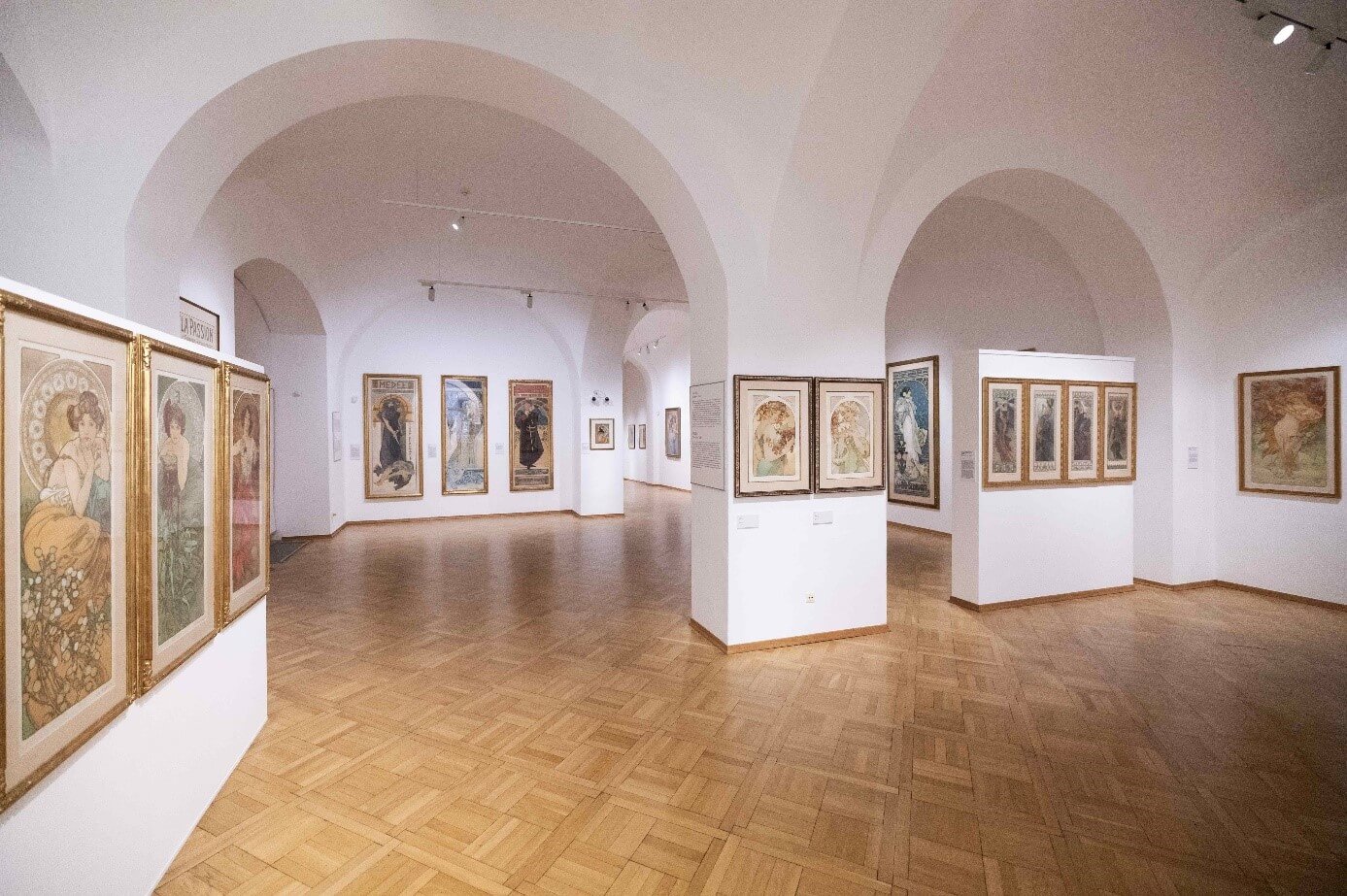
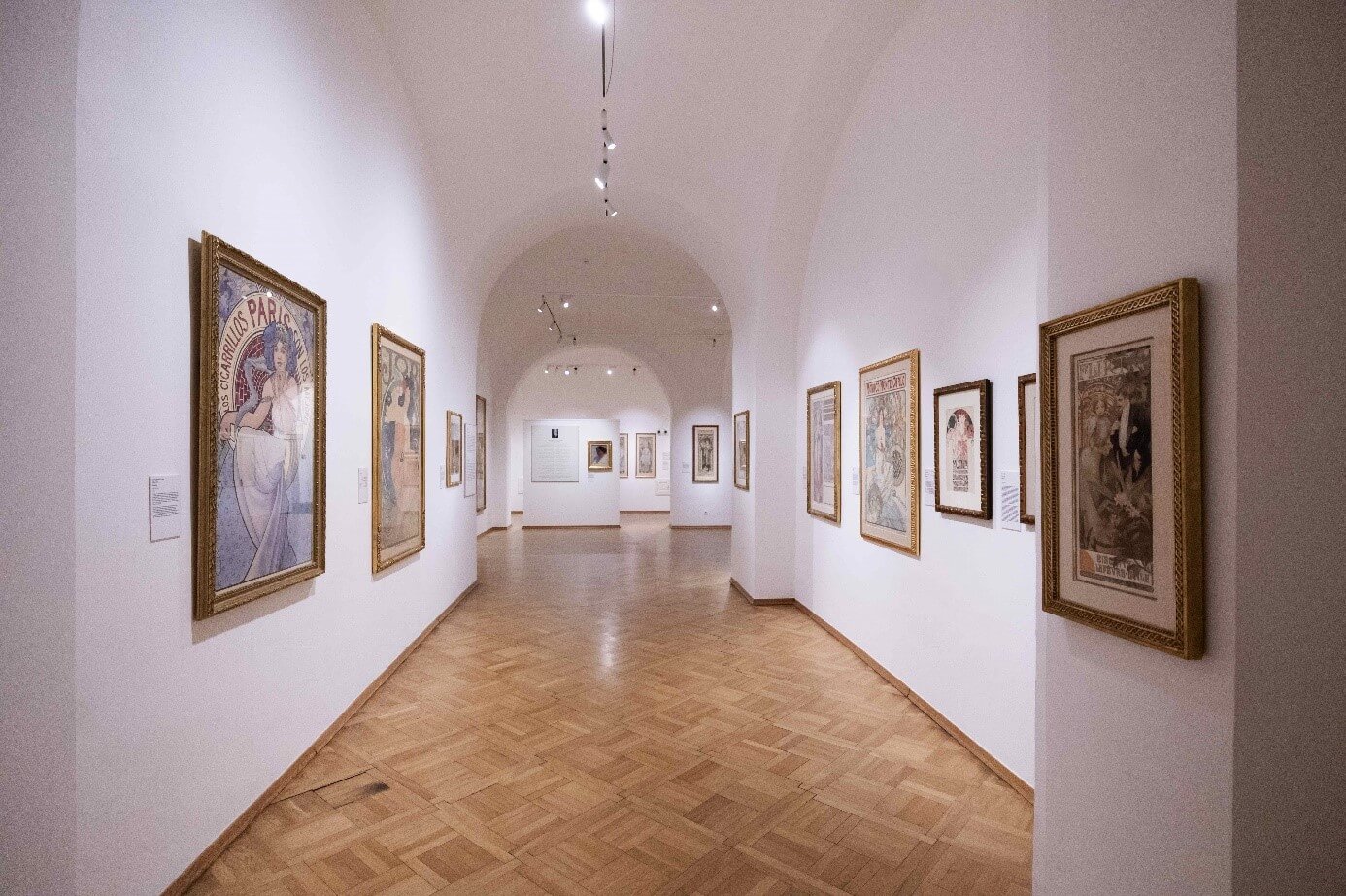
Section 1. Decorative Panels
Alphonse Mucha was a leading exponent of the Art-Nouveau style, which demanded the creation of a decorative scheme that would allow for the repetition of stylistic patterns. Mucha based his work on an image that lent itself to an arrangement in cycles based on traditional themes, usually drawn from the physical world. For this reason, Mucha gave his first set of decorative panels, made in 1896, the title The Four Seasons. He continued this practice with a number of highly successful panels which respect the fourfold or twofold variation on a theme, including The Four Times of Day (1899), or Precious stones (1900) originating during the period when Mucha’s style was already fully developed. The stylized combination of nature and beautiful women was an expression of his joyful vision of life, one greatly appreciated by his audience at the time. From the artistic perspective, The Four Arts cycle (1898) can be considered the most serious among these cycles, executed in several techniques and distinguished especially by the poetic quality of Mucha’s designs. The latest work from Mucha's panels here is The Moon and the Stars series (1902). In this case, the figures are more dramatic than sensual compared to the other cycles.
The Four Arts cycle
In his cycle glorifying the four arts, Mucha deliberately refrained from traditional attributes, such as plumes, musical instruments and painter’s paraphernalia, instead setting each of the arts against a background related to a time of the day; morning for Dance, midday for Painting, evening for Poetry and night for Music.
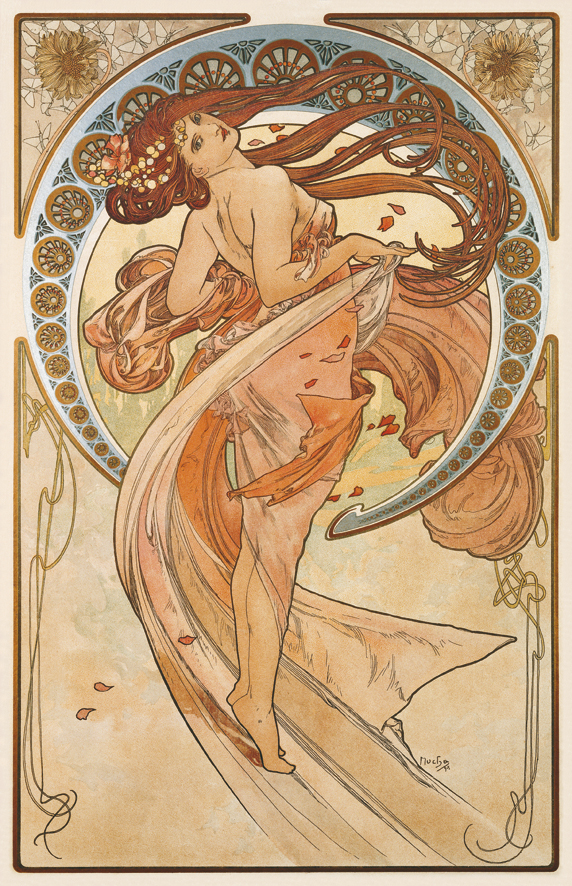
Dance from the Four arts cycle (1898)
© Mucha Museum
The Four Times of the Day
Four female figures represent the times of the day, each set in a natural environment with an intricate framing, reminiscent of a Gothic window.
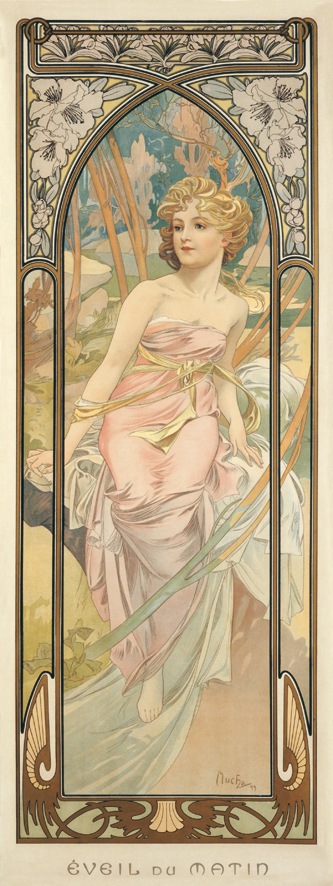
Morning Awakening from The Four Times of the Day (1899)
© Mucha Museum
The Four Seasons
The aforementioned first series of decorative panels, The Four Seasons, was not a new idea – the Champenois printer had previously produced it with other artists – but Mucha breathed so much life into the theme that it became one of the best-selling sets of decorative panels.

Summer from the Four Seasons (1896)
© Mucha Museum
Section 2. Parisian Posters
Posters made in Paris in the 1890s form the best-known and world famous segment of Mucha’s work. It was through them that he managed to promote his own version of the new decorative style. The primary group consists of posters for Sarah Bernhardt, who was a famous Parisian actress. The first of these, created at the very turn of 1894 and 1895, portrayed Bernhardt starring in the role of Gismonda. Extant designs and print proofs for this poster demonstrate, through its stylistic and mainly colour conception, Mucha’s intensive search for a new poster image despite the short time he had for this commission. His artistic revolution brought a certain new elegance to the hitherto highly colourful “street salon”, thus increasing the newly found importance of the poster for modern art. The Bernhardt posters however also include dramatic tones in Médée (1898) and he also portrayed her in male roles, for example in the plays Lorenzaccio (1896) and Hamlet (1899). Also on display are two variants of The Lady with Camellias, a highly popular play about self-sacrifice for love. The last Paris poster was a portrait of Christ for the play Passion (1904). All of these works display Mucha’s extraordinary ingenuity and a sense of visually effective form.
Gismonda
This is the poster that made Mucha famous. The story of its creation is legendary, with many commentators arguing over its details. There is no question that Mucha himself saw the hand of fate in the circumstances which led to the creation of this poster.
The story took place at Christmas of 1894. Mucha was doing a favour for a friend, correcting proofs at Lemercier’s printing works when Sarah Bernhard called the printer with an urgent order for a new poster for Gismonda. All of the artists who normally worked for Lemercier were on holiday and so he turned to Mucha. A demand order from “the divine Sarah” could not be ignored. The poster that Mucha produced was revolutionary in its genre. The long, narrow shape, soft pastel colours and the stillness of the figure captured in a near-life size produced a surprising sense of dignity and gravity which was quite startling. The poster became so popular among the Parisian public that some collectors would bribe the bill stickers to get it, while others would even cut them out from the hoardings at night.
Sarah Bernhardt was delighted with the poster, immediately offering Mucha a six-year contract for the creation of stage and costume designs and posters. At the same time, the artist also signed an exclusive contract with the printer Champenois for commercial and decorative posters.
Lorenzaccio
In Alfred de Musset’s play Lorenzaccio, Sarah Bernhardt played the male hero, Lorenzo de’ Medici, at the time of the siege of Florence by the tyrant Duke Alexander, who is symbolically rendered as a dragon menacing the Florentine coat of arms. Lorenzo contemplates the murder of Alexander, which is depicted in the bottom segment of the poster.
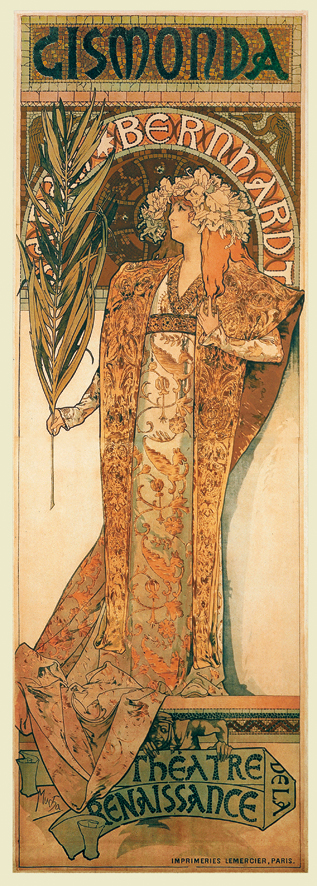
Gismonda (1894-5)
© Mucha Museum
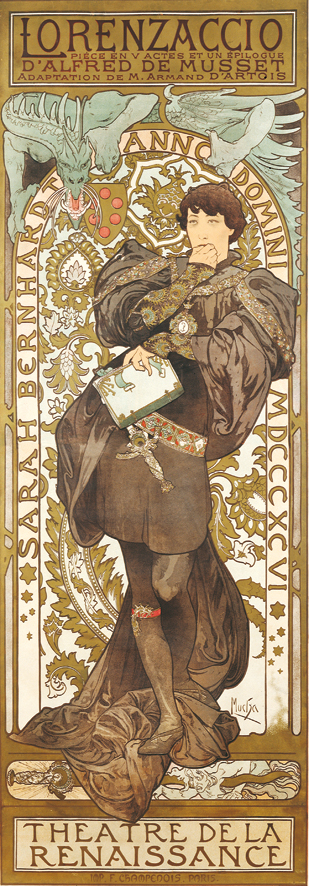
Lorenzaccio (1896)
© Mucha Museum
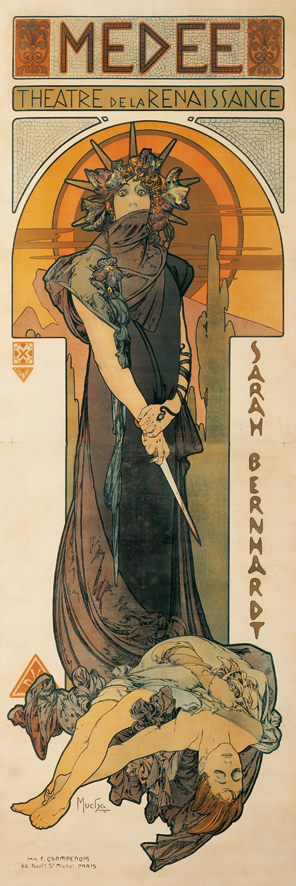
Médée (1898)
© Mucha Museum
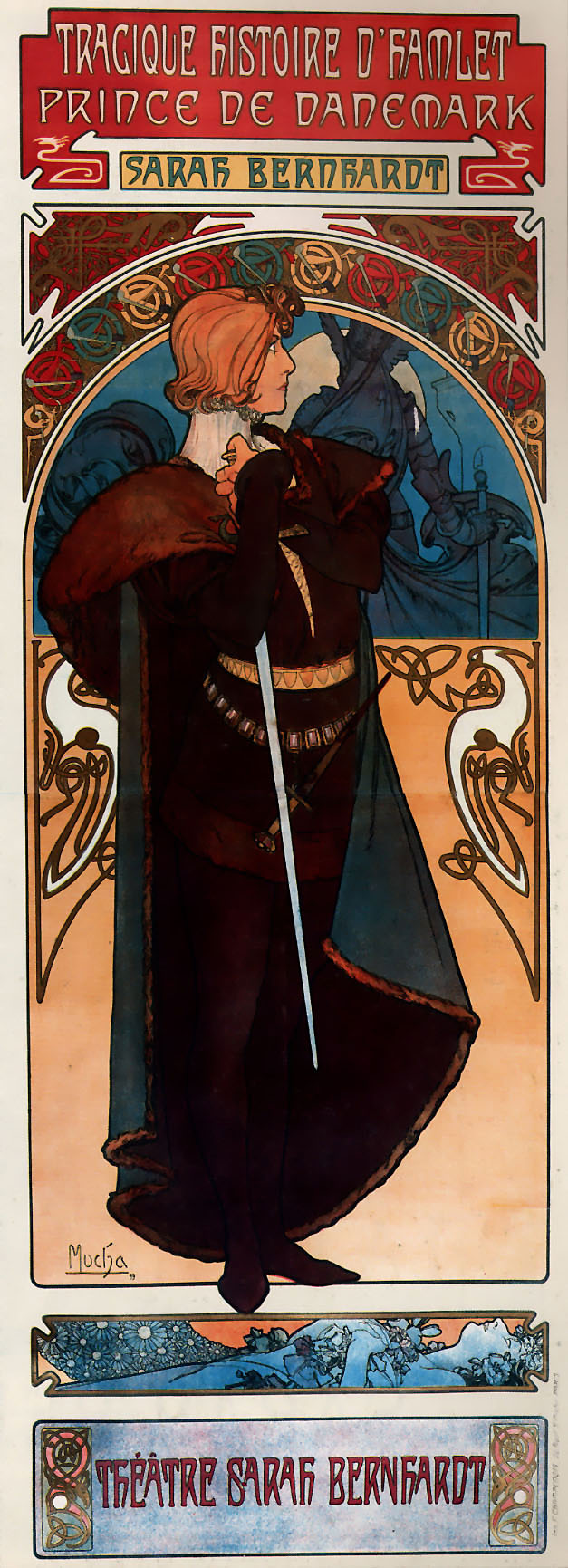
Hamlet (1899)
© Mucha Museum
Médée
Playwright Catulle Mendes adopted Euripides’ classical text especially for Sarah Bernhardt, depicting the Greek hero Jason, hitherto perceived as an untouchable mythological ideal, as a ruthless deceiver who had betrayed all who loved him in pursuit of his selfish passions, thereby giving Médée the psychological justification for her terrible crime. The poster renders the substance of the tragedy through a lonely figure. The mosaic background and letter “D” of the Greek alphabet situates the play in ancient Greece. Médée’s gaze, full of horror, is fixed on the shining dagger in her hand, stained with the blood of her children who are lying by her feet. The unusually detailed hands and the serpentine bracelet adorning Medea’s forearm are quite remarkable. This bracelet was designed by Mucha during his work on the poster and Sarah liked it so much that she commissioned jeweller George Fouquet to create a snake bracelet and a ring embellished with gemstones for her to wear on stage.
Hamlet
Sarah Bernhardt starred in the main male role in Shakespeare’s Hamlet, translated into French for her by Eugène Morand and Marcel Schwob. Behind the central figure of Hamlet, the ghost of his murdered father haunting the ramparts of Elsinore appears in the background. Ophelia, who had drowned, lies, decorated with flowers, in the segment by Hamlet’s feet. Hamlet was the last poster Mucha made for Sarah.
Section 3. Advertisements
Alfons Mucha's commercial work was central to his fame, particularly his product and brand posters during the Belle Époque. The breakthrough came in 1894 with the aforementioned Gismonde poster for the actress Sarah Bernhardt, which led to commissions from major companies such as **Moët & Chandon**, **Job Cigarettes** and **Lefèvre-Utile Biscuits**. The most impressive poster in this section is a commission for Nestlé – A Tribute from Nestlé (1897) – a gift to Queen Victoria to celebrate her 60th jubilee. Mucha's posters depicted elegant, slender female figures surrounded by floral motifs and flowing lines, epitomizing the art nouveau style. His designs elevated everyday products and made them synonymous with beauty and luxury. However, in addition to product advertisements, his commercial commissions also include banners for events such as Paris 1900, the Brooklyn Exhibition 1920 or the Monaco-Monte Carlo poster, encouraging Parisians to visit the bay. Through lithography, these works were mass-produced, combining fine art with advertising and shaping contemporary marketing trends.
Zodiac
One of Mucha’s most popular designs, Zodiac was originally made for Champenoise as an 1897 in-house calendar. However, the editor in chief of La Plume liked it so much he bought the rights to distribute it as the magazine’s calendar for the same year. There are at least 9 versions of Zodiac, including this one, which was printed without any accompanying text to serve as a decorative panel.
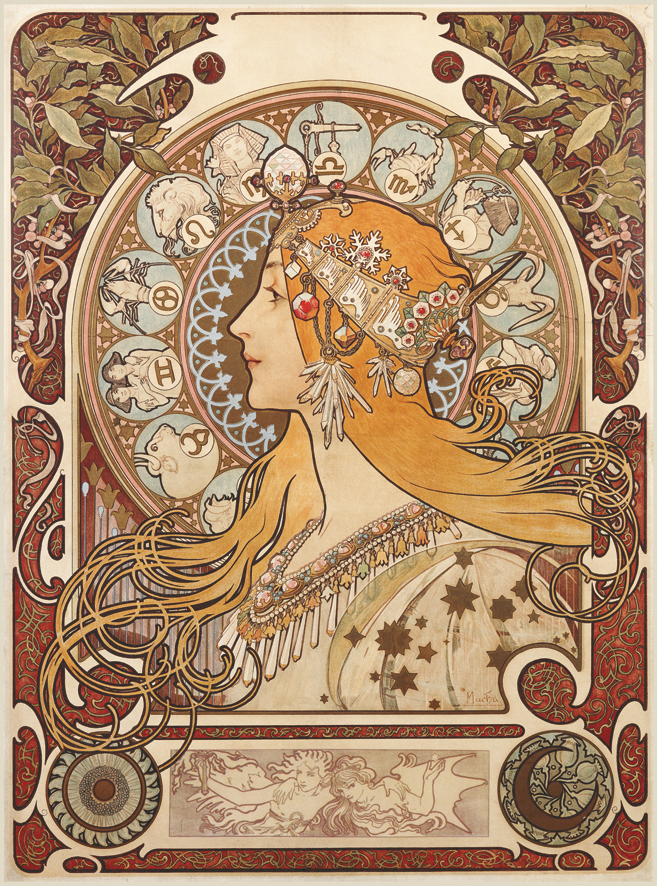
Zodiac (1896)
© Mucha Museum
Moët & Chandon
For Moët & Chandon, Mucha created a series of designs that were used on menus, postcards, and other advertising materials. Two of these commissions were posters; one was used to promote their white champagne, while the other was used to promote their Dry Impérial wine.
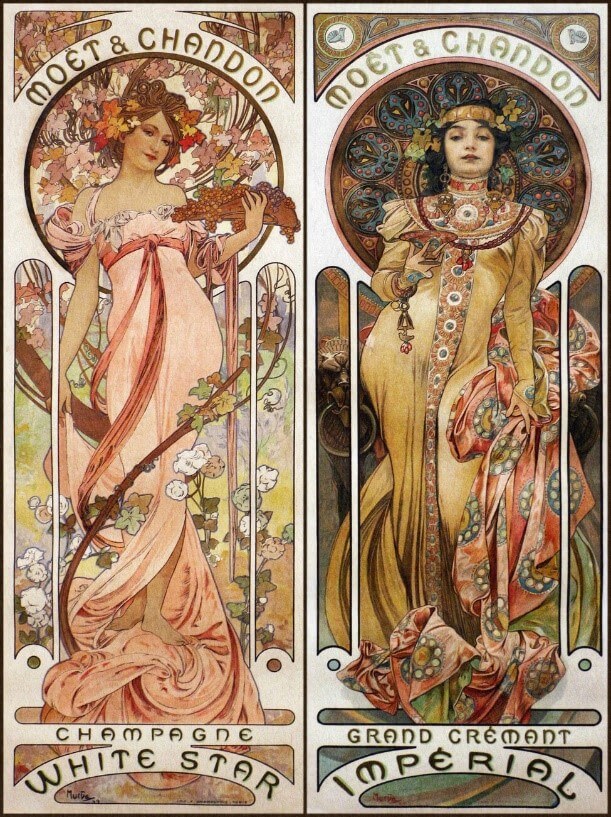
Moët & Chandon (1899)
© Mucha Museum
Monaco Monte-Carlo
Mucha created a very rich design here. The shy girl, kneeling and captivated by the calm of Monte-Carlo Bay, is completely surrounded by the curving stems of lilacs and hydrangeas, with some of the most delicate petals Mucha ever painted being found here. Since the client was a railway – the Chemin de Fer P.L.M. – it is likely that the design was intended to evoke the tracks and wheels that transport the public to Monte-Carlo.
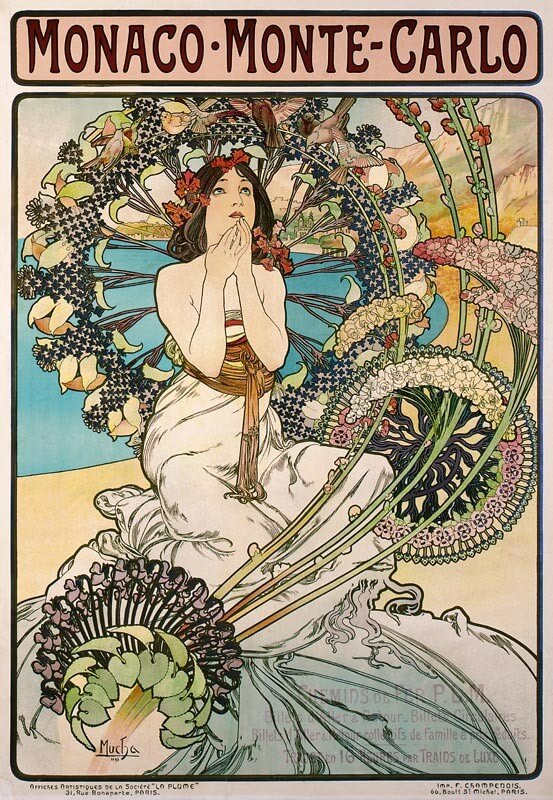
Monaco Monte-Carlo (1897)
© Mucha Museum
Section 4. Czech posters
After his permanent relocation back to his homeland in 1910, Alphonse Mucha returned to his long-held desire to systematically and single-mindedly, through his art, address his fellow people and express their needs and ideals. Gradually a new set of posters emerged, quite distinct in design from the Parisian ones. In terms of theme, we mainly encounter a newly grasped folklore motif, emphasizing the colourful beauty of Moravian folk costumes and the gentle Slavic type of girls represented here by the Moravian Teachers' Choir (1911). He received the contract for the Slavia (1907) Mutual Insurance Bank in Prague while he was still in the USA. There is also a poster for his most monumental work - The Slavic Epic (1928), which is as if cut out of a piece of the Oath of Omladina under the Slavic Linden Tree. We end the section with a lyrical recollection of Parisian motifs with Princess Hyacinth (1911).
Princess Hyacinth
The poster for Princess Hyacinth promotes Ladislav Novák and Oskar Nedbal’s pantomime ballet, starring popular actress Andula Sedláčková. The hyacinth motif recurs throughout the design, from the embroidered garments and spectacular silver jewellery to the symbolic circle held by the princess.
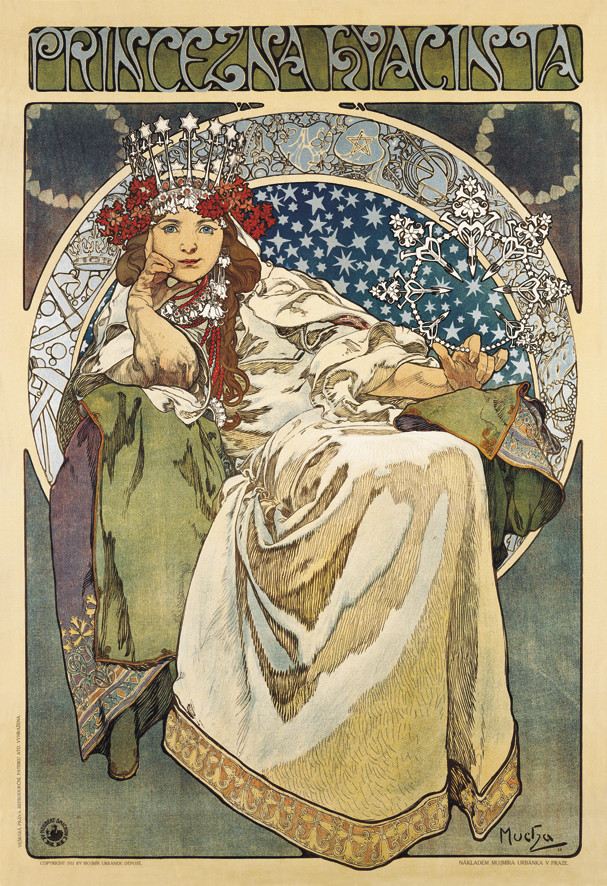
Princess Hyacinth (1911)
© Mucha Museum
The Moravian Teacher's Choir
The Moravian Teacher's Choir was a choral ensemble, whose repertoire ranged from classical to popular and folk music, including compositions by Leoš Janáček. The choir toured in the Czech Lands as well as throughout Europe and the United States. The poster features a young woman wearing a folk costume from the Kyjov region, depicted as an attentive listener. Her figure is reminiscent of the decorative panel of Music from The Four Arts cycle.

The Moravian Teacher's Choir (1911)
© Mucha Museum
Section 5. Memorabilia
In this section of the exhibition, you will have the opportunity to view Mucha's smaller works. Alphonse Mucha designed a number of stamps, banknotes and other national symbols for the newly formed Czechoslovakia after World War I. A proud patriot, Mucha was deeply committed to the cultural and political identity of his homeland. His designs for the Czechoslovak postage stamps in 1918 were a valued contribution to the formation of an independent state after the collapse of the Austro-Hungarian Empire. The banknotes, which Mucha was commissioned to design in 1919, featured Mucha's typical style of ornamental, flowing lines and motifs depicting national identity. Other exhibits on display here include his illustrated Lord's Prayer, as well as personal letters and postcards.
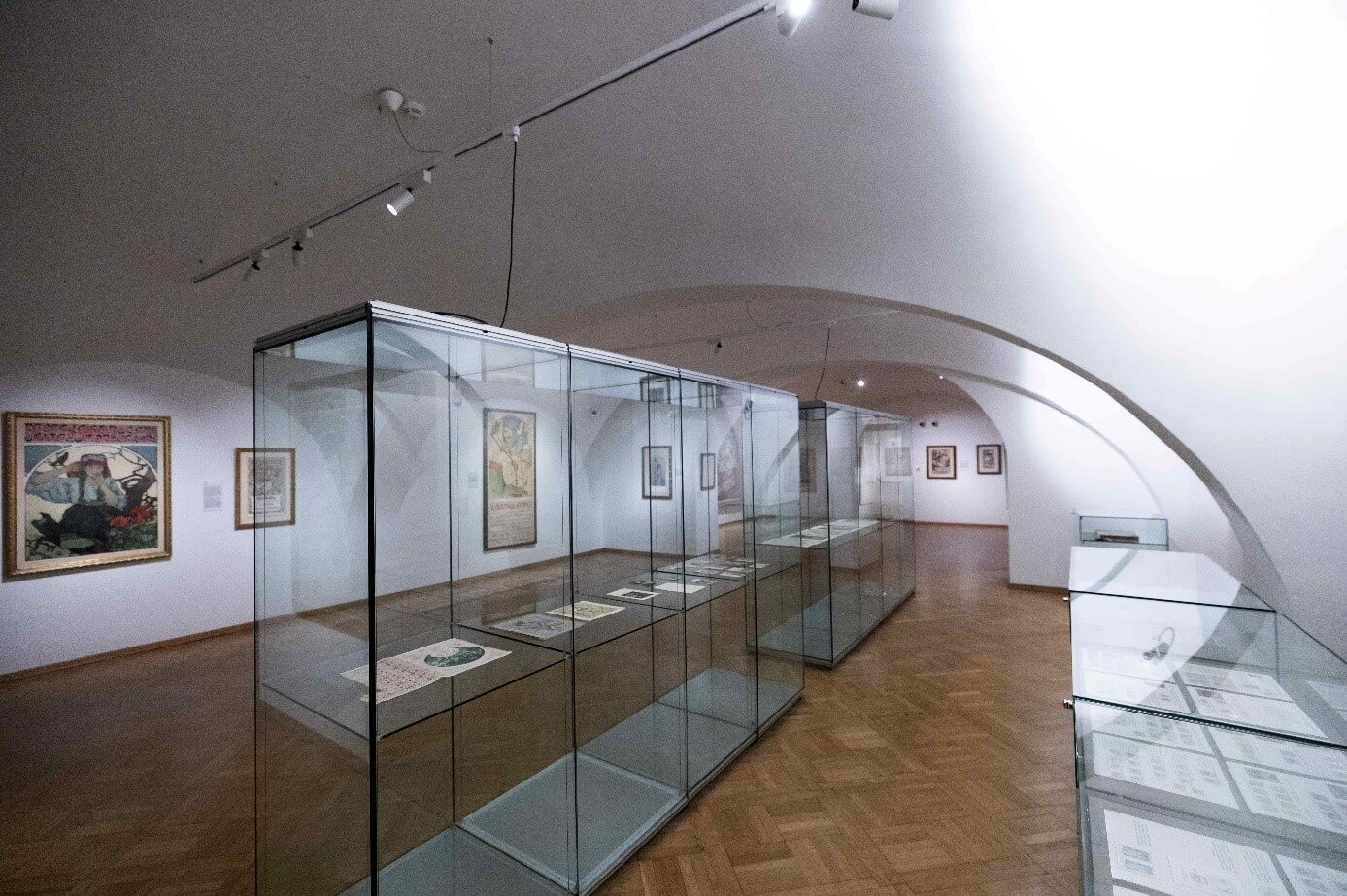
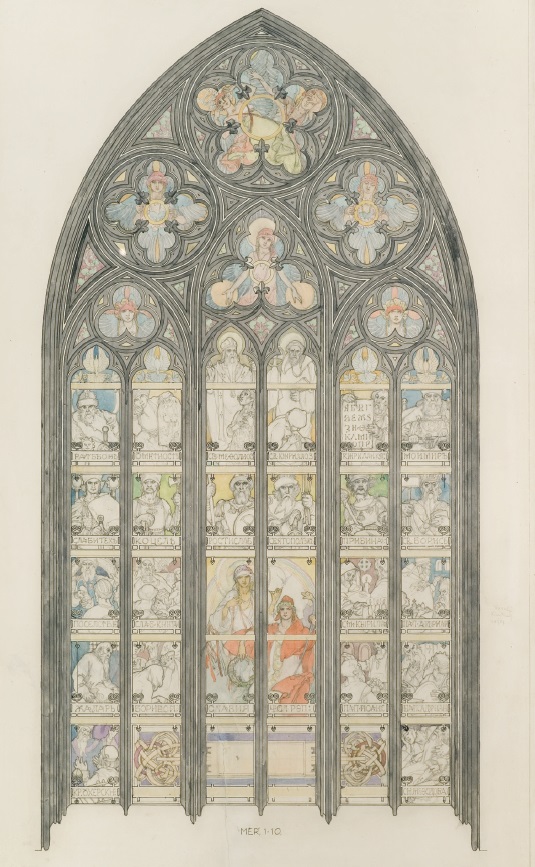
Stained glass design for St. Vitus Cathedral in Prague (around 1900)
© Mucha Museum
Le Pater – title page and five subsequent pages
Mucha considered Le Pater (The Lord’s Prayer) to be one of his best works. It was printed in Paris in an edition of 510 numbered copies (390 in French and 120 in Czech) by Henri Piazza, to whom Mucha dedicated the work.
Mucha wrote of Le Pater: “At that time I saw my path as lying elsewhere, higher. I searched for a means that would spread the light to the remotest corners. I did not have to look long. The Lord’s Prayer. Why not render its text through images?”
In Le Pater, Mucha divided the prayer into seven verses. Each verse is analysed in a set of three decorative pages. On the first page, Mucha presents the verse in Latin and French in a decorative composition of geometrical and symbolic motifs. The second page renders Mucha’s commentary on the content of the verse, imitating medieval illuminated manuscripts in the colour decoration of the initial letter. The third page contains Mucha’s monochrome interpretation of the verse. These visionary illustrations represent man’s struggle on his path from the darkness into light.
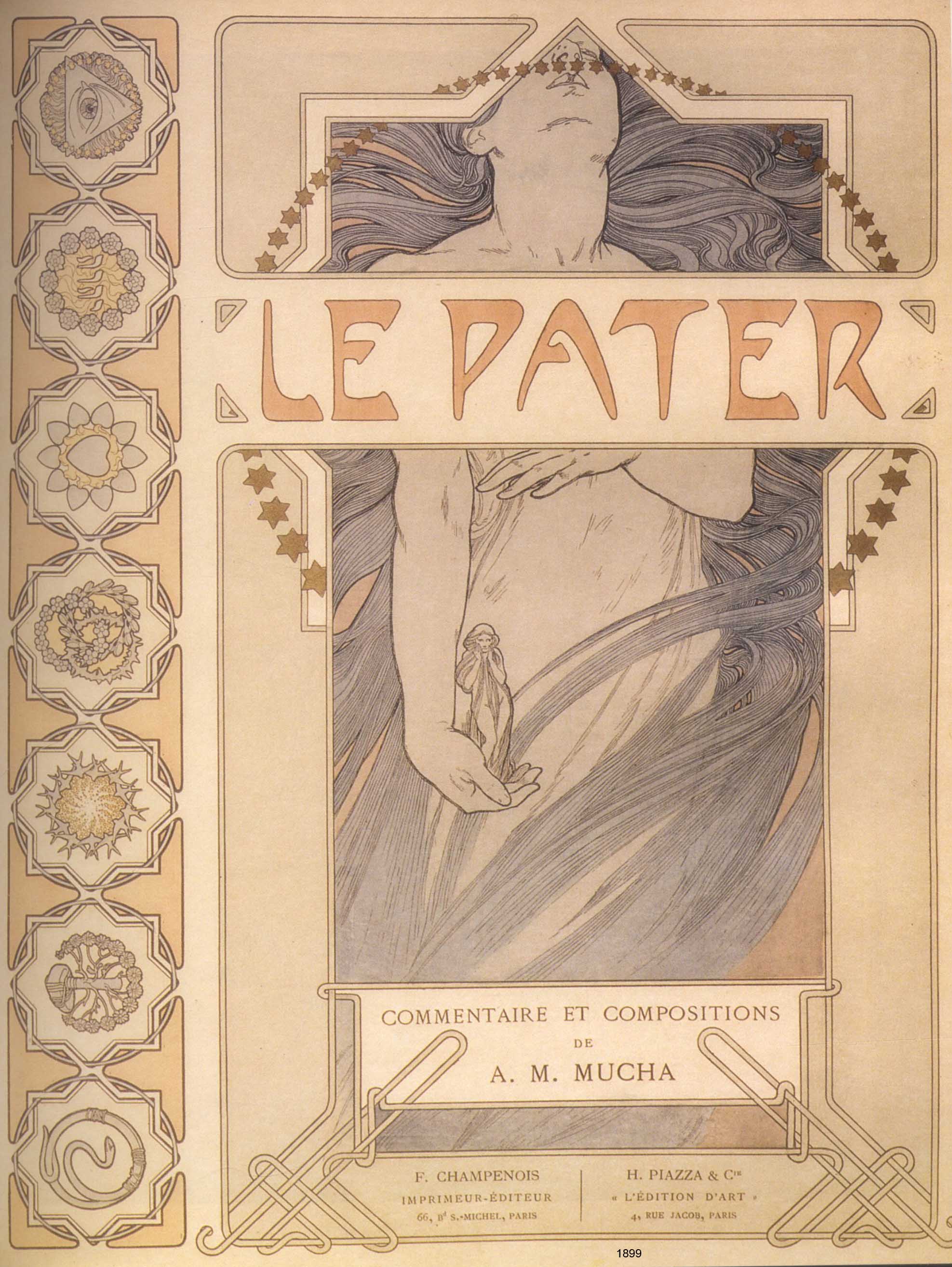
Le Pater (1899)
© Mucha Museum


